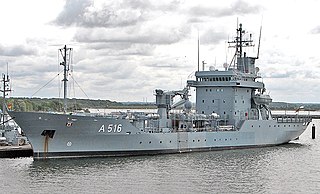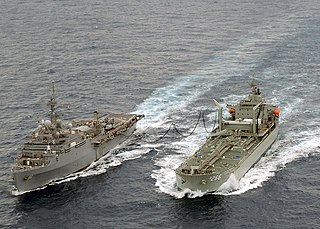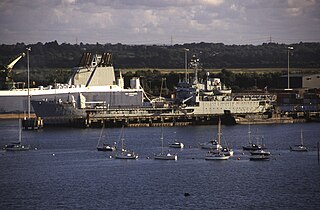
A ship is a large watercraft that travels the world's oceans and other sufficiently deep waterways, carrying goods or passengers, or in support of specialized missions, such as defense, research and fishing. Ships are generally distinguished from boats, based on size, shape, load capacity, and tradition. In the Age of Sail a "ship" was a sailing vessel defined by its sailplan of at least three square riged masts and a full bowsprit.

Maritime/Ocean transport, fluvial transport, or more generally waterborne transport is the transport of people (passengers) or goods (cargo) via waterways. Freight transport by sea has been widely used throughout recorded history. The advent of aviation has diminished the importance of sea travel for passengers, though it is still popular for short trips and pleasure cruises. Transport by water is cheaper than transport by air, despite fluctuating exchange rates and a fee placed on top of freighting charges for carrier companies known as the currency adjustment factor (CAF).

A port is a maritime facility which may comprise one or more wharves where ships may dock to load and discharge passengers and cargo. Although usually situated on a sea coast or estuary, some ports, such as Hamburg, Manchester and Duluth, are many miles inland, with access to the sea via river or canal. Because of their roles as a port of entry for immigrants many port cities such as London, New York, Shanghai, Los Angeles, Singapore and Vancouver have experienced dramatic multi-ethnic and multicultural changes.

The United States Merchant Marine refers to either United States civilian mariners, or to U.S. civilian and federally owned merchant vessels. Both the civilian mariners and the merchant vessels are managed by a combination of the government and private sectors, and engage in commerce or transportation of goods and services in and out of the navigable waters of the United States. The Merchant Marine primarily transports cargo and passengers during peacetime; in times of war, the Merchant Marine can be an auxiliary to the United States Navy, and can be called upon to deliver military personnel and materiel for the military. Merchant Marine officers may also be commissioned as military officers by the Department of Defense. This is commonly achieved by commissioning unlimited tonnage Merchant Marine officers as Strategic Sealift Officers in the United States Navy Reserve.

A ship's tender, usually referred to as a tender, is a boat, or a larger ship used to service or support other boats or ships, generally by transporting people or supplies to and from shore or another ship. Smaller boats may also have tenders, usually called dinghies.

A stevedore, longshoreman, docker, or dockworker is a waterfront manual laborer who is involved in loading and unloading ships, trucks, trains or airplanes.

A merchant ship, merchant vessel, trading vessel, or merchantman is a watercraft that transports cargo or carries passengers for hire. This is in contrast to pleasure craft, which are used for personal recreation, and naval ships, which are used for military purposes.

The United States Maritime Administration (MARAD) is an agency of the United States Department of Transportation.
Its programs promote the use of waterborne transportation and its seamless integration with other segments of the transportation system, and the viability of the U.S. merchant marine. The Maritime Administration works in many areas involving ships and shipping, shipbuilding, port operations, vessel operations, national security, environment, and safety. The Maritime Administration is also charged with maintaining the health of the merchant marine, since commercial mariners, vessels, and intermodal facilities are vital for supporting national security, and so the agency provides support and information for current mariners, extensive support for educating future mariners, and programs to educate America's young people about the vital role the maritime industry plays in the lives of all Americans.
This is a partial glossary of nautical terms; some remain current, while many date from the 17th to 19th centuries. See also Wiktionary's nautical terms, Category:Nautical terms, and Nautical metaphors in English. See the Further reading section for additional words and references.

Roll-on/roll-off ships are cargo ships designed to carry wheeled cargo, such as cars, trucks, semi-trailer trucks, trailers, and railroad cars, that are driven on and off the ship on their own wheels or using a platform vehicle, such as a self-propelled modular transporter. This is in contrast to lift-on/lift-off (LoLo) vessels, which use a crane to load and unload cargo.

A replenishment oiler or replenishment tanker is a naval auxiliary ship with fuel tanks and dry cargo holds which can supply both fuel and dry stores during underway replenishment (UNREP) at sea. Many countries have used replenishment oilers.

The War Shipping Administration (WSA) was a World War II emergency war agency of the US government, tasked to purchase and operate the civilian shipping tonnage the US needed for fighting the war. Both shipbuilding under the Maritime Commission and ship allocation under the WSA to Army, Navy or civilian needs were closely coordinated though Vice Admiral Emory S. Land who continued as head of the Maritime Commission while also heading the WSA.

Sealift is a term used predominantly in military logistics and refers to the use of cargo ships for the deployment of military assets, such as weaponry, vehicles, military personnel, and supplies. It complements other means of transport, such as strategic airlifters, in order to enhance a state's ability to project power.

An auxiliary ship is a naval ship designed to operate in support of combatant ships and other naval operations. Auxiliaries are not primary combatants, although they may have some limited combat capacity, usually of a self-defence nature.

USS Yancey (AKA-93/LKA-93) was an Andromeda-class attack cargo ship built by the Moore Dry Dock Company of Oakland, California for the United States Navy during World War II. The ship was named in honor of Yancey County, North Carolina.

The United States Army Transport Service (ATS) operated Army transport ships for both troop transport and cargo service between United States ports and overseas posts. This service is often confused with the Army Transportation Service, created in France in 1917 to manage American Expeditionary Forces transport, renamed Transportation Corps 12 November 1918 still limited to France, becoming a general service under the Quartermaster Corps responsible for land and water transport, then briefly a name applied to a larger organization in the early days of World War II, and becoming the separate Transportation Corps effective 31 July 1942.
An Yue Jiang is a People's Republic of China container vessel operated by the state-run shipping firm COSCO. In 2008, it became notable because of controversy surrounding a cargo of arms and ammunition destined for Zimbabwe. The cargo reportedly includes some 3 million rounds of small arms ammunition, 1,500 rocket propelled grenades, and 2,500 mortar rounds. The vessel originally planned to dock at the South African port of Durban and unload its cargo for shipment to landlocked Zimbabwe. However, there were widespread protests by persons concerned that the arms would be used by Robert Mugabe's regime in suppressing political opposition in the wake of disputed elections. Dock workers stated that they would not unload the cargo, and others threatened to stop the shipment on South African roads. Finally, a South African judge ruled that the ship could not dock as planned.

In shipping, break bulk cargo or general cargo are goods that must be loaded individually, and not in intermodal containers nor in bulk as with oil or grain. Ships that carry this sort of cargo are called general cargo ships.

Marchwood Military Port (MMP) or Marchwood Sea Mounting Centre (SMC) is a military port located in Marchwood, Southampton on the south coast of the UK, and the base of 17 Port & Maritime Regiment Royal Logistic Corps. The port was built in 1943 to aid in the D-Day assault on Normandy in 1944 and has since been used to support the Falklands War.

MS Lofoten is a Norwegian passenger and cargo vessel owned and operated by Hurtigruten ASA. The ship was built in 1964. After MS Nordstjernen was retired from coastal service in 2012, MS Lofoten became the oldest ship in the current fleet still in operation. It operates cruises around the coast of Norway and sometimes in the Svalbard archipelago. The vessel was declared worthy of preservation in 2001 by the Norwegian Director General of Historic Monuments to preserve Norway's cultural heritage. She has been refitted several times—in 1980, 1985, 1995 and most recently in 2004.

















